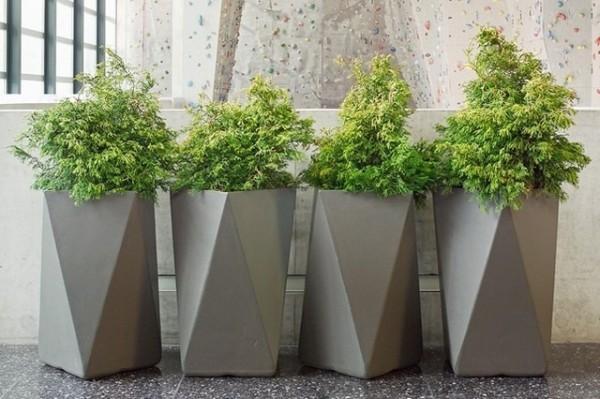A Quick Staghorn Fern Maintenance Guide
Staghorn ferns are arguably the weirdest member of the fern family. These epiphytic plants work best when they’re mounted on the wall and allowed to grow sideways. If you plan on growing them in this manner, you need to make sure their root is mounted on a support. Once secure, the needs of the fern aren’t different than the needs of other ferns. However, they do require the occasional unique deployment of these needs in order to properly thrive.
The Beauty of a Staghorn Fern
Staghorn ferns aren’t your ordinary plant, let alone your ordinary fern. In fact, it’s fair to call these beauties living art since one of the preferred methods to grow them is to mount them on a wall. The reason they can do this is because they’re epiphytic, meaning they have the ability to affix themselves to a non-ground surface.
Staghorn ferns used to be rare finds at the local gardening center, despite the fact that there are 17 different species of the plant. However, they’ve become easier to find these days thanks in part to a specific type of staghorn species that’s native to Australia.
A Video Example of a Mounted Staghorn
A properly mounted staghorn may not look like much in its youth. Yet give it time to grow, and you’ll be hard pressed not to be impressed by its grandeur. This video does a great job of capturing this “before and after” affect that this plant can bring, regardless of where you’re planning on hanging its base.
Hanging a Staghorn – Don’t Be Afraid!
The alien-like appearance of a fully grown staghorn fern looks oddly beautiful. Yet because it essentially grows sideways, it can look like an intimidating piece of greenery to cultivate.
There is no need for intimidation. Staghorn ferns are easy to grow as long as you give it sufficient space to do its thing. Apart from that requirement, tending to the needs of a staghorn fern isn’t much different than what you would need to do for a typical fern.
What’s more, most nurseries sell staghorn ferns pre-mounted. This should eliminate any concerns you may have about “assembling” the plant prior to hanging it. And again, if you give the fern sufficient space to grow, you’ve already fought half the battle.
If you’re a do-it-yourself kind of gardener, mounting a staghorn fern is as easy as your average arts-and-crafts project. You’ll need either a mountable surface like a piece of wood or a sire structure clumps of sphagnum moss, and a homemade barrier to keep things in place. This latter component can be something as simple as a tight circle of nails.
Once the barrier is in place on the surface, tightly pack the moss within the barrier and slide the staghorn fern in the moss – as long as the barrier is compact, the plant won’t go anywhere. If you have a fertilizer component like bone meal, you can also include it into this mixture to proliferate the plant’s growth.
If the notion of dealing with a mounted staghorn fern is too much to deal with, you can always simply grow it in a suspended basket. It won’t have the dramatic near-alien look about it, but it will still look pretty cool.
Caring for Your Staghorn Fern: Let There Be (Some) Light
Although staghorn ferns look unorthodox compared to other ferns, the basic care they require is similar to what you’d find in other ferns. If you’ve had success in growing other ferns, you probably won’t have an issue with getting the most out of your staghorn. They just require slightly different strategies.
Take light, for example. Like most ferns, staghorns thrive in indirect light, and direct exposure to sunlight will end up doing more harm than good. With that being said, there is one component to lighting that requires extra thought with a staghorn fern – positioning.
With ferns, it can be optimal to move their spot around so they can maximize their intake on indirect sunlight throughout the calendar year. Because most staghorn ferns are mounted, you’re most likely not going to have this luxury.
As such, you’ll need to take where you hang your fern into careful consideration. Typically, you’ll want to place them in a room where sunlight exposure comes in from either the south or the east, as the light tends to be less harsh due to the positioning of the sun. If you subject the fern to western or northern exposure, the sunlight they’ll receive may be a bit harsh.
How Do You Water a Staghorn?
Because staghorn ferns are planted differently, watering the plant is a twofold process. The first step of the process is misting, which can be a common component in dealing with ferns in general. Make sure you use a spray-bottle that produces a fine mist, aiming for the antler fronds.
The second part, soaking, is a bit unorthodox. Essentially, this part requires taking the entire plant and its support off its mount and submerging it for about 10 to 20 minutes, until the plant’s root is saturated. You’ll want to make sure the water used is at room temperature.
You can also put the plant and its support in a sink and allow water to run through the root until it’s soaked. With either method, you’ll want to allow the plant to drip-dry before re-hanging. The soaking method will ensure the root will get thoroughly soaked, and it won’t leave a wet mess in the vicinity of the plant – a bonus if you’re growing the plant indoors.
There isn’t a set rule regarding the frequency of watering your staghorn, as factors like light, heat, and humidity provide too much variance. However, you should plan on watering your fern once a week when it’s warm, and once every two to three weeks when it’s cold.
If you follow these steps, your odd-looking, wall-mounted fern will provide you with a fascinating piece of plant life you’ll be excited to display to your guests. The process needed to get to this endgame may be a little unorthodox compared to other ferns, but these extra quirks will pay off very handsomely if you give it time.
Photo by Mokkie Licensed Under CC BY-SA 3.0



Hi, the text quality is very good, because it covers most of the topics. but it would be better if you also wrote about maintenance boots.
Sorry! I didn’t notice the maintenance part. now i saw it!